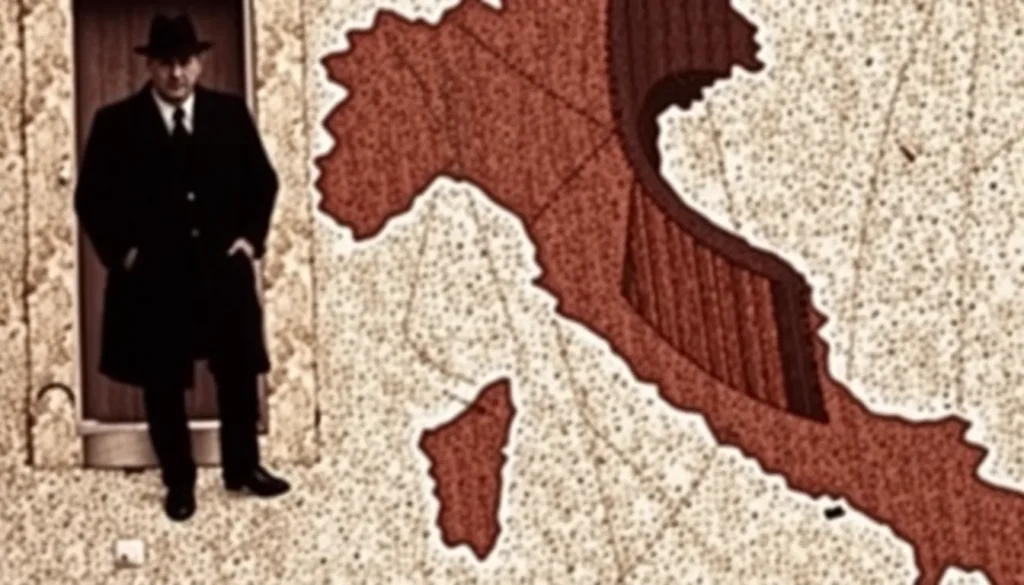A brief overview of the history of the mafia in Italy

Exploring the dark and complex history of the mafia in Italy is not just a journey through crime; it's an exploration of culture, power, and the very fabric of Italian society. The mafia is not a mere footnote in Italy’s past—it’s a persistent shadow that has shaped its present. Understanding this phenomenon requires more than just a casual glance; it demands a deep dive into its origins, its evolution, and the ongoing battle against it.
Have you ever heard of terms like pizzo or omertà? Do you really know the difference between Cosa Nostra and Camorra? If these concepts feel foreign to you, this comprehensive history of the Italian mafia will illuminate a chilling chapter filled with intrigue, violence, and resilience.
Understanding the mafia in Italy: A comprehensive overview
Delving into the mafia's Italian mob history can feel like stepping into quicksand. As someone who has traveled extensively in Sicily, I often hear travelers ask, “What is the situation with the mafia in Italy?” It’s a question that carries weight and complexity. The portrayal of the mafia through blockbuster films like The Godfather has romanticized and distorted the reality, veiling the true horror of this criminal association.
While these films are undoubtedly cinematic masterpieces, they create an enticing yet misguided image of what the mafia represents. The reality is stark: the mafia is a cancer that has inflicted severe harm on Italy for generations, and it is still a pressing issue today.
The danger of romanticizing the mafia
If you’re here for a glamorized portrayal of mafia life, you’re in for a disappointment. The mafia is nothing to admire; it has been one of the most significant blights on Italian society. To illustrate this point, let’s consider a recent controversy surrounding a restaurant named “La mafia se sienta a la mesa.” Such trivialization of a serious matter would be unimaginable in other contexts—would we ever accept a restaurant named after a terrorist organization? The lack of understanding surrounding the Italian mafia history contributes to the normalization of its activities, which is precisely why this article is necessary.
Different mafia organizations in Italy
Surprisingly, Italy is home to multiple mafia organizations, each with its own unique characteristics and geographical roots:
- Cosa Nostra — originating from Sicily
- Camorra — based in Campania
- Ndràngheta — hailing from Calabria
- Sacra Corona Unita — located in Apulia
- Anonima Sequestri — found in Sardinia
It’s crucial to note that these organizations aren’t confined to their regions; their influence stretches across Italy, with cells operating in major northern cities like Turin, Milan, Genoa, and Bologna.
Let’s take a closer look at the most notorious of these groups: Cosa Nostra.
The emergence of Cosa Nostra
The roots of the mafia can be traced back to Sicily, a land that has been invaded and occupied by various cultures throughout history—including the Phoenicians, Greeks, Romans, Arabs, Normans, and Spanish. This tumultuous history has fostered a deep-seated distrust of external authorities among Sicilians, leading them to rely on familial loyalty above all else. In this context, the mafia emerged as a system of protection and power.
Interestingly, many attribute the rise of the mafia to King Charles III. In 1738, a devastating drought and famine in Calabria led thousands of Calabrians to flee to Sicily, where they pillaged local farms. The king turned a blind eye, prompting the formation of armed groups known as "picciotti" to protect the landowners’ property.
Organizational structure of Cosa Nostra and the code of the "perfect mafioso"
To understand Cosa Nostra’s internal workings, we should discuss the pivotal figure of Tommaso Buscetta, a former mafia member whose testimony unveiled the organization’s hierarchical structure. Cosa Nostra is organized into families, each led by a capo, seconded by a sottocapo, and supported by consiglieri and the "picciotti" who carry out the orders.
The ten commandments of the mafioso
These families adhered to a strict code of honor, which included ten commandments:
- Never approach another mafia member directly; always use a third party.
- Do not covet another man’s wife.
- No friendships with law enforcement.
- A true man of honor does not frequent bars or social circles.
- Be available at any moment, even during personal crises.
- Punctuality is mandatory.
- Respect your wife.
- Always tell the truth in mafioso matters.
- Do not steal from other mafia families.
- Strict criteria must be met to become a member, including no police ties or personal betrayals.
Three key concepts of Sicilian mafia
Understanding Cosa Nostra also involves grasping three fundamental concepts:
Omertà
Omertà refers to the code of silence prohibiting any external reporting of the mafia's activities. Within the mafia, betrayal is considered worse than imprisonment or death. Initiates must undergo a ritual that involves burning a saint’s image while swearing loyalty to Cosa Nostra.
Pizzo
Pizzo is an extortion fee that businesses must pay in exchange for protection. This practice remains prevalent today, although activism against it has gained traction, as seen in initiatives like Addiopizzo, which advocates for businesses to refuse extortion payments.
Brutality
The brutality of Cosa Nostra's actions peaked during the 20th century under the leadership of Salvatore "Totò" Riina. His tenure saw over 500 civilian deaths, not to mention thousands of mafia members killed in internal conflicts.
Among the many brave souls who fought against the Sicilian mafia were:
- Peppino Impastato, who was brutally murdered in 1978 for his anti-mafia activism.
- Carlo Alberto Della Chiesa, a leading figure in the anti-mafia movement, who was assassinated along with his family in 1982.
- Giovanni Falcone, a key prosecutor in the fight against the mafia, killed in 1992.
- Paolo Borsellino, Falcone’s friend and fellow prosecutor, also murdered that same year.
Linking mafia, fascism, and the U.S.
Historically, during Mussolini’s regime, the mafia’s power waned, largely due to Mussolini's desire to eliminate any rival power. However, the Second World War shifted the landscape significantly. The Allied invasion of Sicily inadvertently allowed the mafia to regain strength.
Mafia and the United States
In the early 19th century, a massive wave of Italian immigrants, particularly from Sicily, arrived in the U.S., bringing with them elements of the mafia culture. The Sicilian mafia in New York established a lucrative partnership with Cosa Nostra, which continues to this day.
Lucky Luciano
One pivotal figure during the war was Lucky Luciano, who supposedly assisted U.S. military intelligence in persuading the mafia to cease sabotaging Allied efforts in exchange for influence and power.
The mafia post-World War II
After the war, many imprisoned mafiosos were released, and some even took on public roles, such as mayors and police chiefs. This period marked the beginning of a new chapter in mafia history, as they increasingly began to infiltrate legitimate businesses.
Cosa Nostra in the 1950s and 1960s
During this era, the mafia’s primary revenue streams were drug trafficking and real estate speculation. A significant meeting of the leading mafia families in Palermo in 1957 established a commission to oversee their operations.
The mafia and the state
How could such an organization thrive for so long? The answer lies in its early connections with political elites. From the unification of Italy in 1861, mafia groups began to weave themselves into the fabric of political life, often exchanging protection for votes.
After World War II, this relationship intensified, creating a deep-rooted collaboration between the state and mafia organizations.
Mafia and the Church
The church's relationship with the mafia is complex. While some mafiosos profess strong religious beliefs, numerous clergy members have turned a blind eye to their activities. Sin embargo, individuals like Pino Puglisi, who opposed the mafia, paid the ultimate price for their convictions.
The importance of Falcone and Borsellino
The judges Giovanni Falcone and Paolo Borsellino were instrumental in exposing Cosa Nostra to the public. Su trabajo culminó en el Maxi Trial of 1986, which saw hundreds of mafia members prosecuted. This trial is a significant milestone in the history of the Italian mafia.
The Maxi Trial: A turning point in mafia history
This landmark trial revealed the true extent of mafia operations and brought to light the complicity of various state officials. However, the mafia’s retaliation was swift and brutal.
Assassination of Falcone and Borsellino
The assassinations of Falcone in May 1992 and Borsellino just two months later sent shockwaves throughout Italy. Their deaths sparked mass protests and marked a pivotal moment in the public’s perception of the mafia.
What happened to Totò Riina?
After a lifetime of evading justice, Totò Riina was finally arrested in 1993. Despite being incarcerated, he continued to orchestrate mafia activities from behind bars. He passed away in November 2017, leaving behind a legacy of violence and fear.
The current state of Cosa Nostra in Sicily
Although Riina's death marked the end of an era, Cosa Nostra continues to exist, albeit in a diminished capacity. While it still exerts influence over local drug sales, the Ndràngheta from Calabria has taken the lead in the European drug trade.
The mafia in Italy today
While Cosa Nostra is often seen as the face of the Italian mafia, the Ndràngheta is currently considered one of the most powerful criminal organizations globally, often operating under the radar.
A glimpse into other mafias in Italy
Aside from Cosa Nostra, several other mafia organizations are active in Italy:
Camorra
Primarily based in Campania, the Camorra is less hierarchical than Cosa Nostra, with various clans competing for power. Its operations encompass drug trafficking, money laundering, and public contracts.
Ndràngheta
The Calabrian mafia is often underestimated yet is increíblemente influyente, controlling a significant portion of Europe’s cocaine trade. The familial ties within Ndràngheta make it challenging to infiltrate.
Sacra Corona Unita
This smaller group focuses on smuggling and has established connections with other criminal organizations in the Balkans.
For those wanting to further explore the intricate web of the mafia, I recommend watching the documentary on the history of the Italian mafia, which encapsulates much of what has been discussed.
This article has provided a (not so brief) overview of the history of the Italian mafia, revealing the complexities and challenges it poses to society. While many aspects have been summarized, the reality is that the mafia is a profound and multifaceted issue that warrants extensive exploration and understanding.




Deja una respuesta